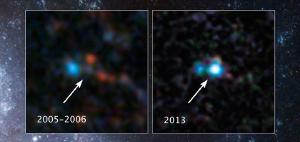Blog
Zombie Jamboree
8 August 2014
 NASA/ESA
NASA/ESAType Ia supernovae have property that is very useful for astronomers. When they explode, they have a maximum brightness that is fairly consistent. This means they can be used as “standard candles” to determine the distance of galaxies billions of light years away. One challenge we have with this type of supernova is that we haven’t confirmed what causes them. The most popular idea is that they are due to a collision of two white dwarfs, while an alternative is that they are due to a binary star system, where a white dwarf star steals matter from its companion. Without confirming a progenitor of a type Ia supernova we can’t be entirely sure.
But we’re starting to get some clues. It turns out that there is a variation of type Ia supernovae known as type Iax. These are similar to type Ia, and have a similar spectrum, but don’t get as bright and the speed of the stellar material isn’t as great. Because of their similarities, it is almost as if type Iax supernovae are almost a failed supernovae. At least that has been an idea. Now a new paper published in Nature has found a progenitor to a type Iax supernova.1
The progenitor the team found was bright blue, and seems to have been a star that has lost its outer hydrogen levels, revealing its helium core. This would be consistent with the idea of a binary system consisting of a white dwarf and red giant. As the white dwarf captures the outer layers of its red giant companion, the hot helium core would be revealed.
Given the size of this particular type Iax supermova, there wasn’t enough energy released to be a complete disintegration of the white dwarf companion (which is one model for type Ia supernovae). This means there should be part of the white dwarf which still exists. It is being referred to in the popular press as a “zombie star.” The team hasn’t confirmed that a zombie star exists, but they plan to observe the region as the supernova dims. By 2015 they may be able to determine if their zombie star idea is correct.
McCully, Curtis, et al. “A luminous, blue progenitor system for the type Iax supernova 2012Z.” Nature 512.7512 (2014): 54-56. ↩︎